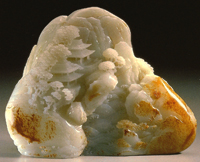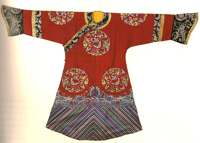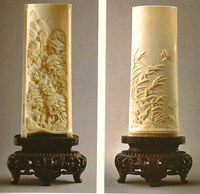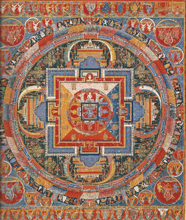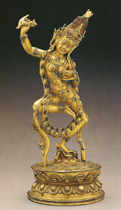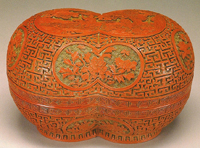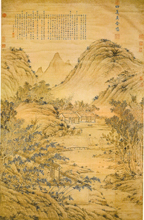Chinese Painting Essentials
-
The following notes comment on the basic features of Classical Chinese Paintings. Although they are not exhaustive, we hope that they help you in better understanding Chinese painting and in joining the experts to talk about Chinese art.
Silk over the centuries was the most important medium in Chinese painting. Invented by Chinese farmers as early as 2,500 B.C., silk was not produced outside of China until well into the first millennium A.D. Made from threads processed from the one-half mile long strands unraveled from the cocoons of silkworms, silk fabric was treated in a variety of ways prior to being used as a ground for painting. Different painters preferred different types of silk, ranging from raw, hard silk to soft silk and edged silk.
Paper was also a popular medium for Chinese painting. At first it was used because it was a more economical and flexible alternative to silk, but by the Yuan dynasty it became the most fashionable medium for literati painting.
A Pointed Brush made from animal hair was the primary tool in conventional Chinese painting. The finest brushes, having a straight tip and no loose bristles, have always been made from wolf hair or goat hair. The former is used for defining the outline of the image, which remains the most fundamental act of Chinese painting practice. Goat-hair brushes are the preferred means for adding color wash within the dominant line.
Ink made from pine resin or tung oil was processed into bars or cakes, which the artist ground together with water for use in painting. Since the Qing dynasty, Qianlong and other high-quality inks have been especially valued because they contain quantities of gold and suffer very little oxidation over the centuries. Different inks were used to create particular visual effects, such as articulating human hair. Colored pigments were derived from a range of mineral and vegetable sources, including cinnabar (red), ochre or iron oxide, cyanine (blue), malachite (green), and azurite (blue).
Seals were used, beginning in the Tang dynasty, to mark ownership or authorship of paintings. As paintings were passed down over the centuries, new owners added their own seals. By tracking the history of seals, the authenticity of the painting can be established.
Three Basic Reasons for Mounting Chinese Paintings in a Scroll Format
Aesthetic Value. The mounting style contributes to the physical charm of a Chinese painting. The presentation of the painting reflects not only the skill or rank of the signed artist but also the craftsmanship of a mounting specialist and the particular taste of the owner of the scroll painting. Each painting is mounted in accord with the creative inspiration associated with the creation of the work in a historical context. For example, if a blue and green landscape (dominated by shade of bright colors), the mounting material needs to be plain and subtle to form a visual contrast for the potential viewer. If an ink landscape painting is mounted on bright colored satins, the awkwardness would shy away a true Chinese art connoisseur. In other words, an inappropriate mounting style will damage the credibility of the work and throw into question the judgment of both artist and patron. Moreover, a repeated mounting practice will certainly flatten the pictorial charm of an original work.
Conservation and Safety. A high-quality mounting prevents the painting from being damaged by improper handling and display or condition deterioration. For example, if certain herbs were added to the glue used for mounting, the scroll painting would escape insect attacks. In general, silk and paper are easily torn, broken, cracked, or damaged. Therefore, a proper conservation would enter the picture to fix the physical problems. However, in the United States, sometimes, the cost for repairing a damaged Chinese scroll painting may exceed the value of the subject scroll. If the scroll conservation is not done properly, the value of a Chinese scroll will be diminished.
Economic Considerations. Although not without cost, having your painting mounted will preserve the quality and increase the value of your painting many times over. Most Chinese scroll paintings circulating in the market are mounted in a China-based workshop, with those held in museums. Hong Kong and Taiwan are two alternatives if you wish to have a Chinese scroll painting custom-mounted. Before you commissioning a Chinese scroll restoration, it would be wise to consult a Chinese painting specialist regarding the value of your Chinese scrolls and the conservation possibilities.
Return to Asian Art Consulting & Appraisal
Reproduction vs. Forgery
Over the history of Chinese art, reproduction of famous classical Chinese paintings was never associated with forgery. Beginning as early as the Tang dynasty (618-907), emperors commissioned the best artists to copy old masterpieces in order to preserve national treasures and protect the cultural patrimony from natural decay. Court artists were appointed to make faithful duplicates of original works held in the imperial collections. For example, Li Gonglin (ca. 1041-1106) of the Song Dynasty was commissioned by the emperor to reproduce Wei Yan's Shepherding, a painting from the Tang dynasty (617-907). Like other artist copyists of renown, Li Gonglin describes the emperor's request and his motivation for copying the painting in his inscription, which draws attention to the pride he took in completing a reproduction of the original.
A reproduction of an original Chinese painting is not a forgery. Copying the masterpieces is a legitimate training method in the Chinese art school. Identified as "Reproduction," "Copy," "In the style of," or "After," quality Chinese paintings have taken many forms in the war of authenticity. In the history of Chinese fine art, high quality Chinese paintings inspired by old masters, undertaken by elite artists using authentic, original materials, are always considered a valid form of artistic creation. By following old masters in iconography, subject matter, painting techniques and calligraphic styles, traditional Chinese painters found their own artistic voices in forms, strokes and colors. A mastery of traditional Chinese painting techniques, cultural traditions and visual aesthetics has endorsed the life long dedication to the perfection of their art creativity. In short, a quality reproduction of an original work by a professional artist deserves a fair quality assessment before identifying it a fake or forgery. Many of the best museums and collections have collected a fair amount of reproduction or copies of original masterpieces.
Collecting fine Chinese paintings marked explicitly as "reproduction," "copy of" or "after" etd. has many merits. First, it allows the viewer to understanding the traditional Chinese art practice, the method of training a fine Chinese painter and the study of Chinese art history. As a Chinese art historian, Chinese art consultant and appraiser myself, I took pride in studying the lineage of Chinese artists from teacher to student, from early generation to later generation, the formation of an art movement and and the dialogue between artists of different schools but the same generation. I have learnt so much about the core of Chinese visual aesthetics and the transformation of Chinese ink brushstrokes or painting methods in an art school or a region. I have become very interested in the effective Chinese art connoisseurship by visual analysis of painting techniques and methods adopted by artists of various generations. We also know that some of the most famous artists of the past century were deeply in debt to old Chinese painting masters. Zhang Daqian (1899-1983), for example, mastered the painting techniques initiated by many old masters, such as those by Bada Shanren (active 1659-1705), to achieve financial gains. Reproductions, includling forgery of works by Bada Shanren and Sitao, created by Zhang Daqian have become the most desirable objects in the current market.
As a Chinese art collector with vision, you should never be intimidated by the word of "reproduction" but pay attention to the quality of the painting and the rank of the signed artist. If the reproduction, or in any other affiliated identifications, is an excellent work of quality by an established artist, you shouldn't hesitate to include it in your collection.
Related Topics: Reproduction is A Method of Conservation
Forgery in China
A forgery aims to deceive in the name of others. Sometimes, the line between a reproduction or copy and forgery or fake is extremely faint, such as the Zhang Daqian case. However, it is not hard to separate a true artist from a craftsman. The former will devote himself to the artistic perfection by investing his heart and sould and the later will only focus on financial gains by completing the work and collecting commissions. Therefore, while juding a Chinese scroll painting, it is important to adopt a prudent approach. It is utterly irresponsible if we label a Chinese painting a forgery or fake because it resembles the work of an old master painter without a careful investigation on the intention of the signed artist.
Forgery is an attempt to hide the copyist's role and proclaim that the later copy is the same as the original. Recently high quality forgeries have made their appearance in auction houses and museums, sowing confusion and consternation among collectors and curators. Some regions were historically known for cheap forgeries. Suzhou, for example, had many skilled craftsmen working on the paintings of Zhao Mengfu (1254-1322) and Wu Zhen (1280-1354), and falsely attributed versions of Shen Zhou's (1427-1509) works were easily purchased in Suzhou. This kind of commercialization and attempt to deceive the viewer stand at the opposite end of the spectrum from reproduction.
Forgery is hardly new in the world of Chinese art. However, bogus pieces, including ceramics, furniture, sculpture and painting, were mainly from China. Even the best museums have recent forgeries in their collections. For example, The provenance of some Chinese paintings in the Metropolitan Museum of Art in New York has recently been challenged. The most disturbing case concerns the authenticity of Riverbank, originally thought to be a 1,000 year-old scroll. Some scholars credited it instead to Zhang Daqian (1899-1983), one of the greatest artists of the 20th century in China. The authenticity of the painting remains unsettled.
Quality forgery are marketable. The China-based art market is particularly challenged by the growing power of forgery. Many known artists have devoted a large amount of their time on fighting forgery or authenticating their own works. For example, famous Chinese Artist Wu Guanzhong accused a Beijing auction house of selling forgeries of his paintings (Xinhua News, Sept. 8, 2006). An auction, scheduled to open on Sept. 17, 2006 in Beijing, was cancelled because artist Wu Guanzhong testified that none of the paintings for sale is by his own hand. Unfortunately, the forgers are never going to be stopped, because the business of forgery is financial and social, a part of human history. The only thing a Chinese art collector can do is to exercise his dual diligence by studying Chinese art history and connoisseurship and engaging art professionals for guidance.
Have Questions about Asian Art? Need Professional Chinese Art Consulting Service? Need Asian Art Appraisal ? Want to Know more about the Chinese Art Market ? Want to Know Where and How to sell your Art?
Our Asian Art Appraisals are conducted by Dr. Wei Yang (Ph.D. in Chinese art, a certified art appraiser and an Accredited Senior Appraiser of Asian Art designated by American Society of Appraisers). We are committed to a thorough investigation of your art work, large or small. We serve you with respect, integrity and objectivity.
Need Asian Art Consultation or Appraisal? Please Contact Us or call us at (609) 688-6891
We Consult & Appraise Asian Art
